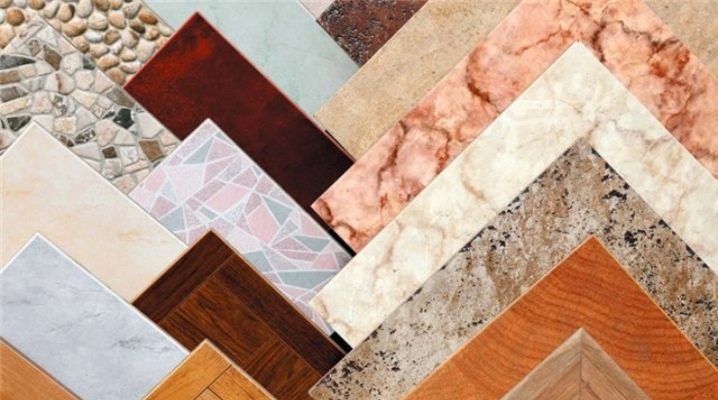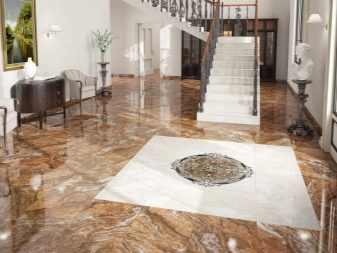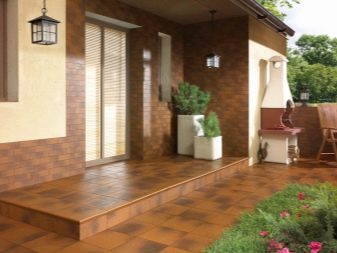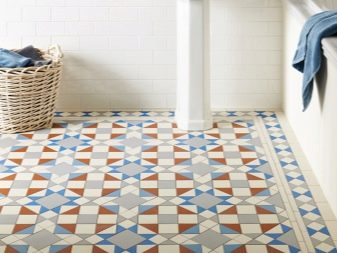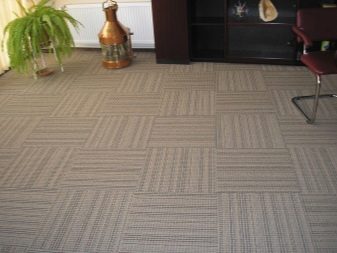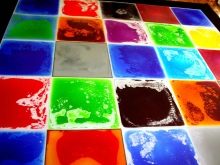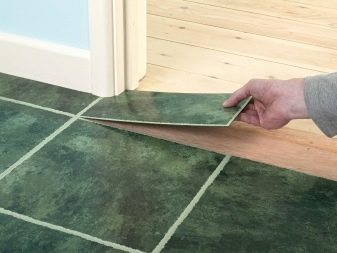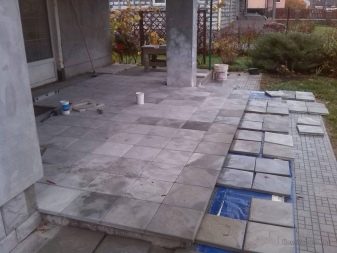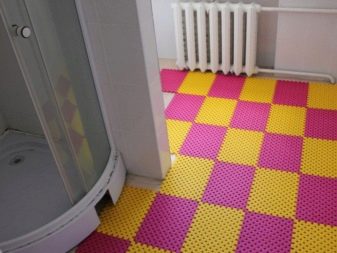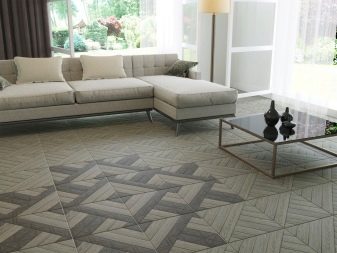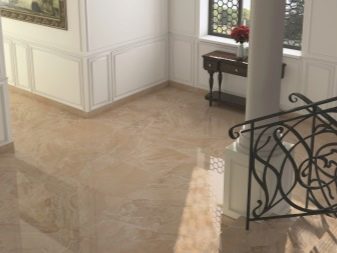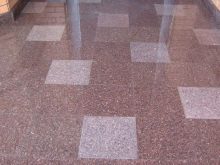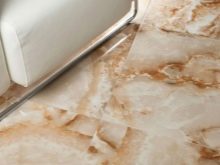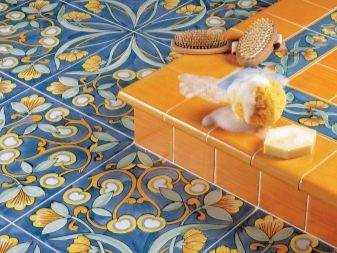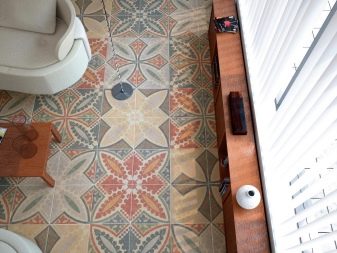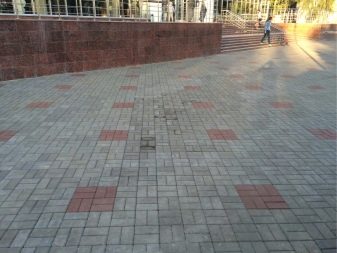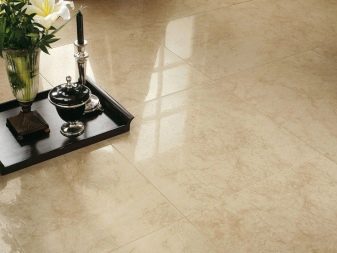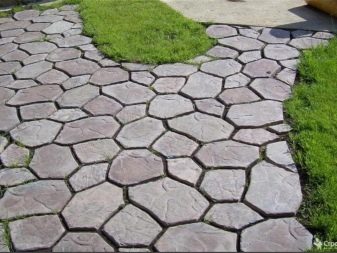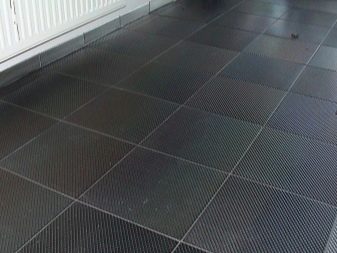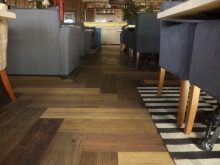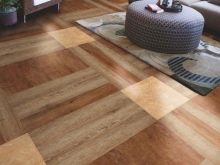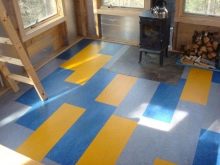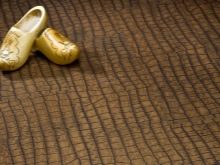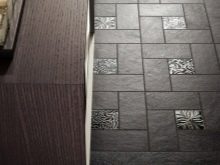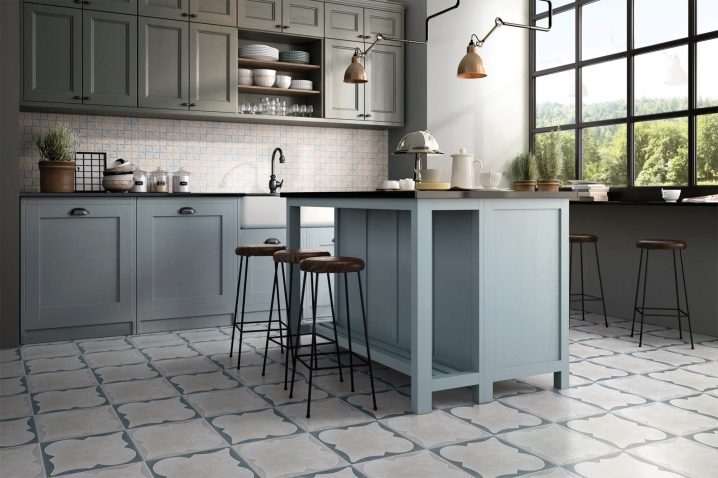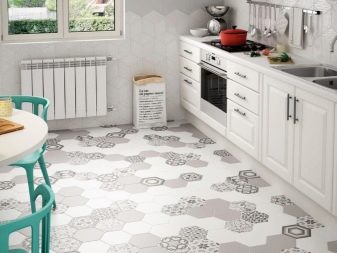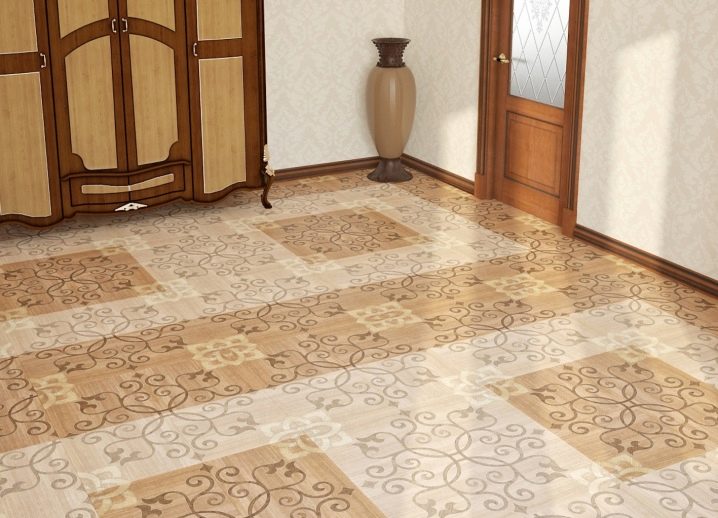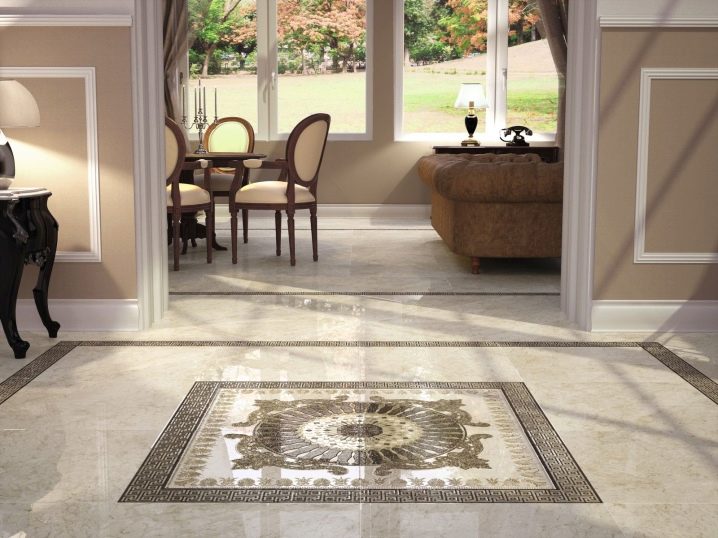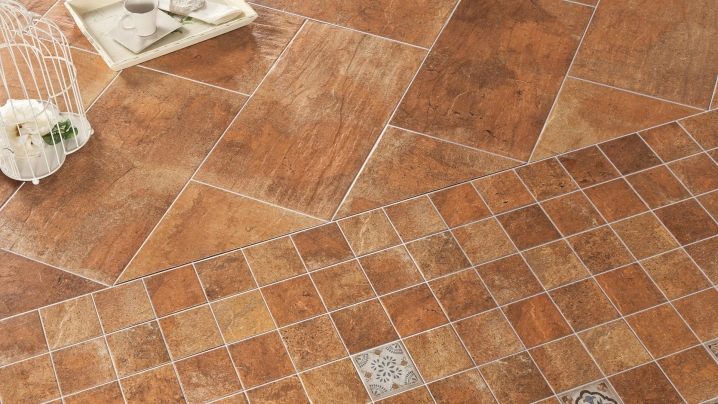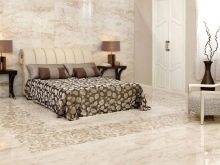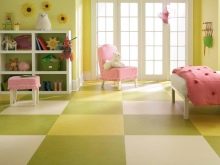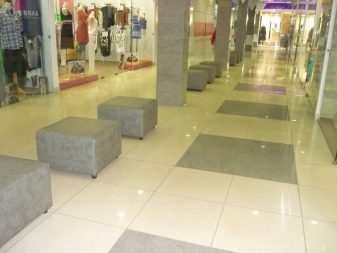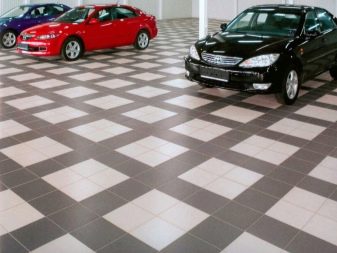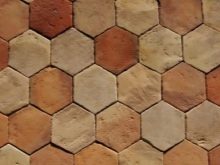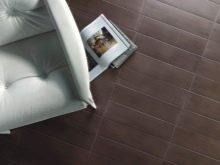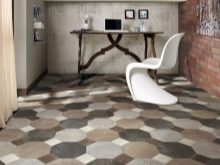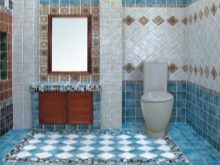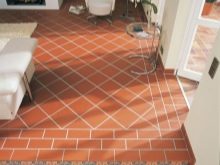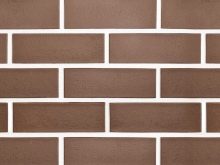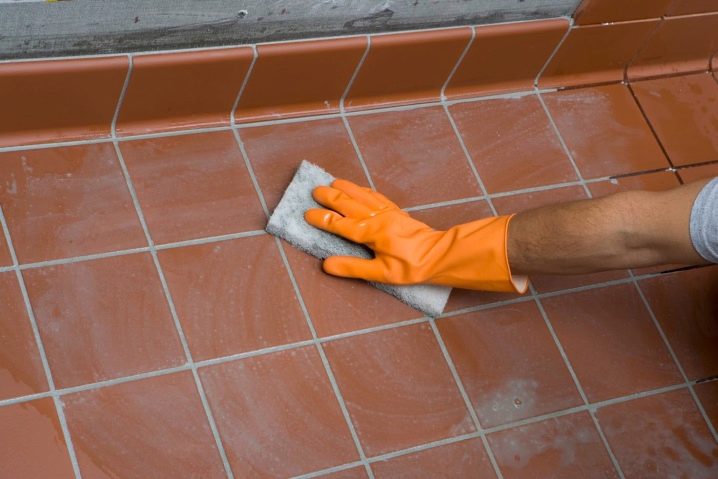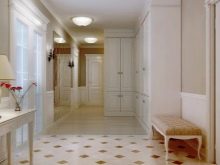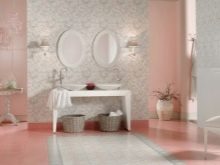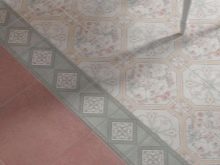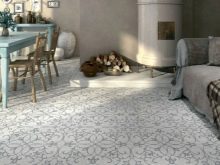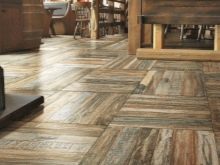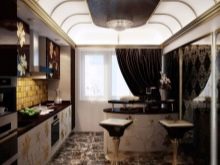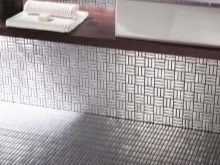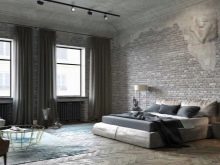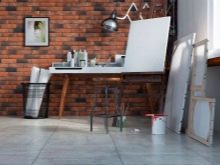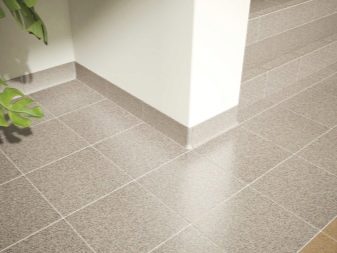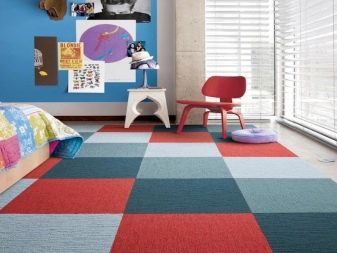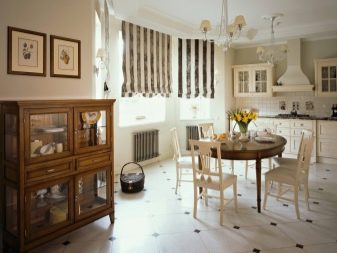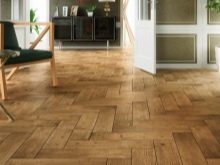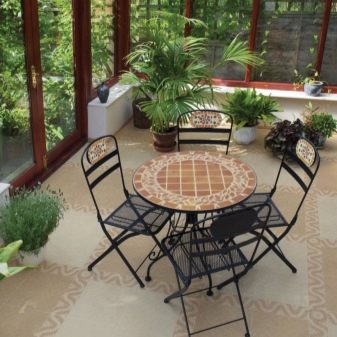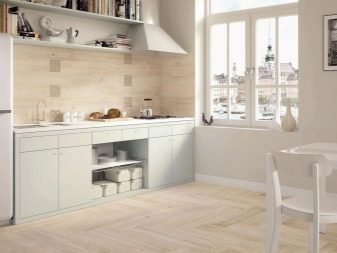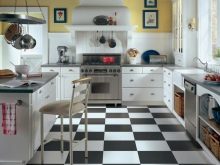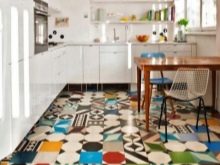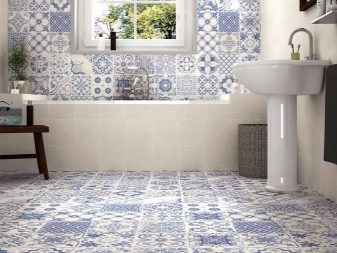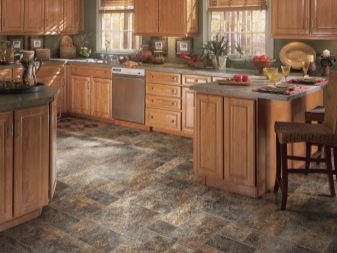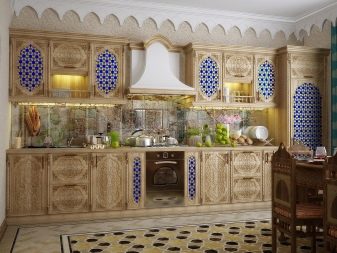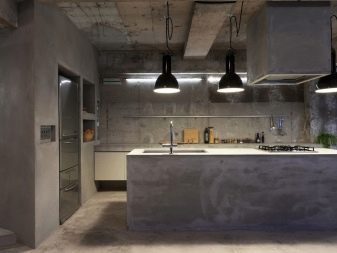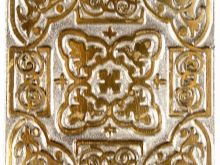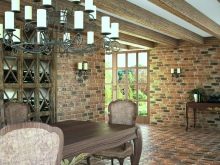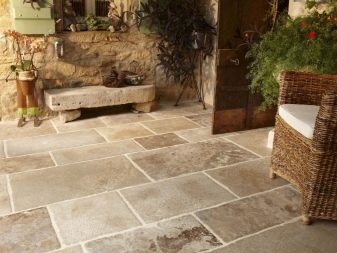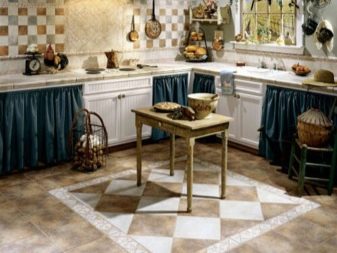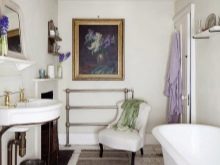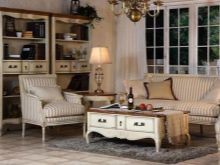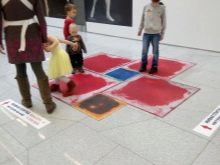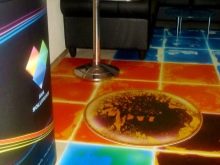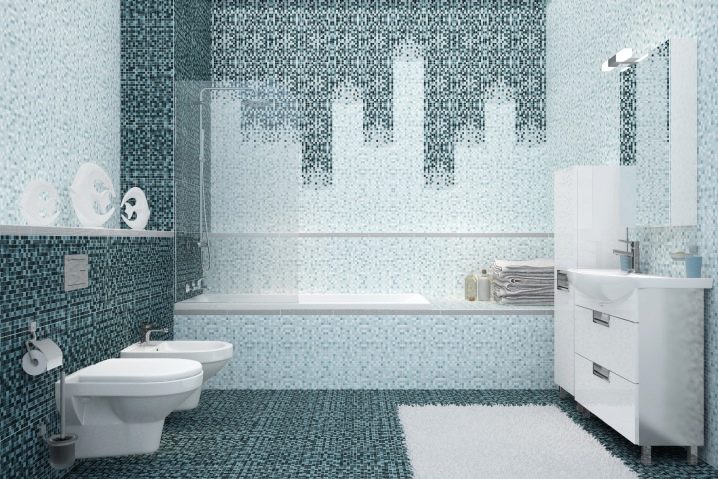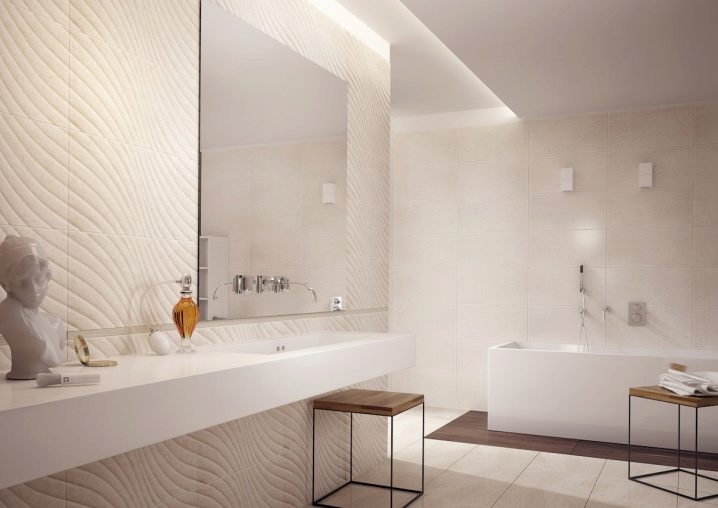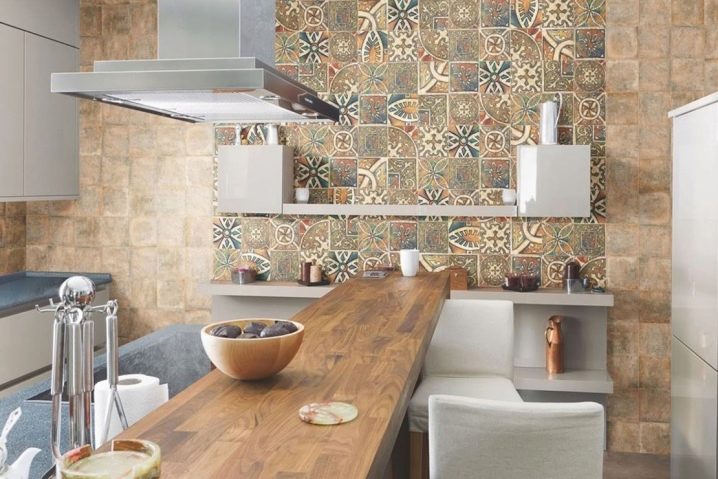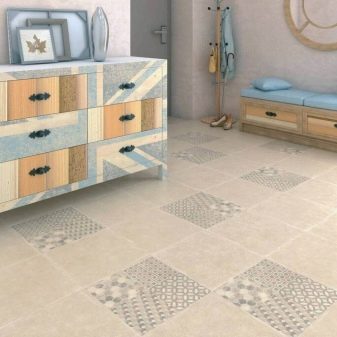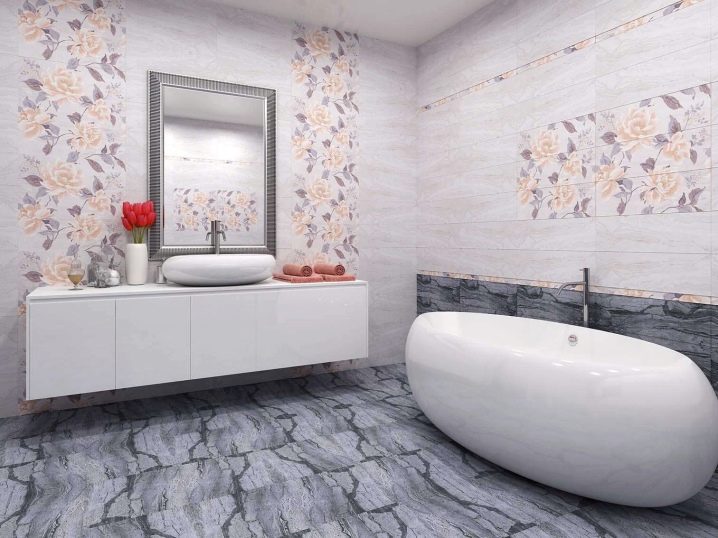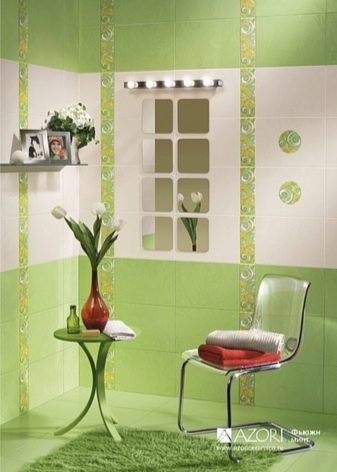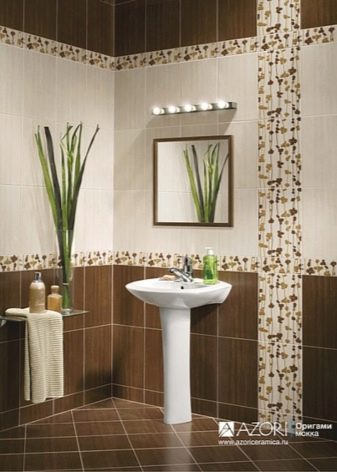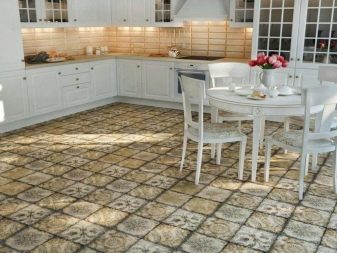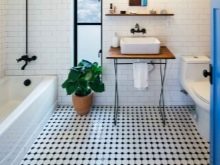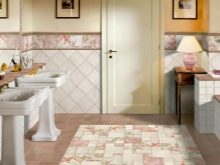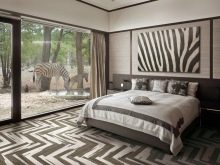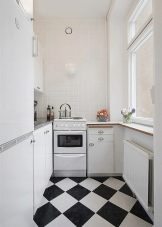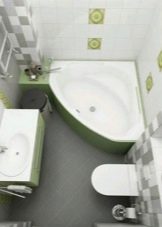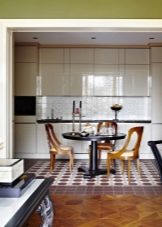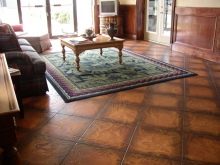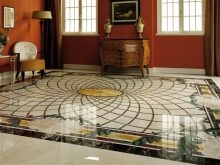Floor tiles: varieties and nuances of choice
The floor tile is a finishing material designed to not only improve the performance of the floor in the room and protect it, but also to introduce original design elements to decorate it.
Kinds
The modern market of floor coverings offers many types of tiles, different in design, texture, color, technological features and production method.
Depending on the material, several main types can be distinguished.
- Slabs of natural stones - The most expensive option. The rock is frost-resistant, durable, which allows it to be used for the treatment of floors both outside and inside the house. Granite and marble surfaces are polished or heat treated.
- Fake diamond. Ceramic granite products have an advantage over natural ones, which is expressed in simpler care, a variety of textures and colors.
- Ceramic granite is obtained by dry pressing a mixture consisting of kalinic clay, feldspar, quartz sand and other mineral additives, followed by roasting. The tile has an excellent thermal conductivity, which allows it to be used for the installation of the "warm floor" system.
- Ceramic tile has the widest scope. Differs in extraordinary variety of models, shades, patterns. The production technology causes differences with porcelain stoneware. The stages of making ceramics are two: getting the base, painting and firing. The lack of high-pressure processing explains the fragility of the products.
- Clinker tiles produced in an extrusive manner. It is suitable for interior and exterior decoration, which contributes to the extraordinary resistance to aggressive influence from the outside. Demanded when facing terraces, steps and garden paths.
- Metlahskaya tile It is named after the German city in which it was first released.A distinctive feature are bright patterns that are resistant to abrasion. Due to such operational features as strength, moisture resistance and chemical resistance, the coating is widely used to cover floors and paths.
- Cotto - tiles of high strength, which is characterized by unglazed surface and porosity. The outer layer is rough or polished. As a rule, the coating has a natural reddish or yellow-brown color. Special dyes are not added during production. Experts recommend rubbing the material before using wax wax to prolong its service life.
- Carpet tiles one of the warmest of the proposed options. Designers love to use it in children's rooms and bedrooms. At its core, the coating is similar to carpet, but instead of a monolithic canvas there are small elements. On the one hand, this is convenient, since it is possible to easily replace a small area in case of damage. On the other hand, it is difficult to clean such a floor: carpet is the strongest “dust collector”, which requires constant cleaning with a vacuum cleaner and household cleaning products.
Modern technology does not stand still, so it appeared new "live" 3D tilewhich immediately attracted designers with its originality.
The peculiarity is that the pattern changes under mechanical action. During the passage under your feet there is a game of shades or a change of patterns. This effect is achieved by gel filler. The original idea is widely used in various bars and nightclubs.
Users identified a few flaws:
- the base for the tile must be perfectly flat so that the gel substance does not flow to one side;
- the high cost of production makes it less affordable.
There are other types of floor tiles depending on the chosen base material: metal, plastic, concrete, etc.
Wear resistance
According to regulatory documents, floor tiles are available in five classes. The first is characterized by the smallest degree of resistance to wear, and the fifth is large.
Depending on the classification, make a choice for laying in a particular room. In public places with the constant presence of a significant number of people recommend plates 4-5 class.
Materials
Types of plates and their performance properties depend on the base material.
- Stone tile. It turns out from natural rock - granite, marble, onyx, travertine, sandstone.
- Marble and granite they are durable and resistant to sudden changes in temperature. Decorative properties are not inferior to them: original drawing, soft shades. The polished surface enhances the nobility of the stone palette, makes the colors deeper.
- Granite tiles stronger than all natural flooring materials. Marble is more porous, therefore, it absorbs soils well and, as a result, requires careful maintenance.
- Onyx slabsAs a rule, it is used in the form of decorating small areas. Contrast spectacular pattern in the form of waves and lines are impressive.
- Travertine strength inferior to all the above materials. With aging, the stone becomes more beautiful, enhancing the decorative effect. The outer layer is velvety, pleasant to the touch. Natural colors range from gently cream to dark brown, which allows you to combine stone with wood trim.Travertine plates are not afraid of moisture, they are laid in bathrooms.
- Ceramics or tile. The tile is a variety of ceramic. It is obtained by baking clay pigs. An enamel is painted with an ornament on top, and the tile is fired again. To protect the decorative layer of the top varnish is applied. Since the raw materials used are abundant, the technology is not labor-intensive and does not require much time. This is one of the most affordable flooring. In addition, the variety of colors, patterns, sizes make the range almost unlimited.
Good thermal conductivity and moisture resistance characteristics make it possible to use ceramic tiles everywhere. However, fragility reduces the lifetime. Of the disadvantages also note the cold surface. Ceramics are great for installing the system "warm floor".
- Ceramic granite and clinker material surpass ceramics in their performance and are not inferior to products made of natural stone. The differences are in the production method, but the operational features are similar. They allow you to get imitations of different materials, not only natural, but also artificial.Porcelain is usually of a wider size, whereas clinker can be in the form of small "bricks".
- Metal rarely used for decorative purposes. In most cases, they trim the floor in industrial premises or laboratories, where he is under tremendous pressure. According to technical standards, metal flooring is laid on a concrete screed. Even less often for the same purpose serves a cast iron stove.
- Concrete used in the manufacture of paving slabs for the improvement of urban areas, squares, playgrounds, paths.
- Cork tiles does not attract dust, so it is indicated for allergies. The cork does not rot, does not become covered with mold, it is pleasant tactile. This floor is a good heat and noise insulator. Marked deficiency - quickly comes into disrepair. Due to its softness and porosity, the material is subject to mechanical stress.
- PVC. Plastic floor tiles have a not very high coefficient of wear, but easy to maintain, so it is primarily in demand in small office spaces. Users are also pleased with its affordability.
- Polyurethane Floor Tiles It is a composite material with a wide range of shades, textures. As a rule, the mixture consists of hardened vinyl, rock crumb, plasticizer.
Experts note that such material requires laying on a completely flat floor.
- Leather tile - a novelty in the world of coatings. It looks great in any interior style: ethnic, colonial, art deco. The material is expensive, therefore less accessible to ordinary buyers. The structure of the floor option includes the initial stoneware layer and the upper decorative calfskin. The skin is impregnated with special preparations for strength.
Specifications
The reasons for the popularity of floor tiles lie in its technical characteristics, which are practically only advantages.
- Wear resistance. According to this indicator, the material is divided into 5 classes.
- Strength. Surface hardness is classified on a ten-point scale by the MEP. Professionals advise in hallways and corridors, where the floor is exposed to street dirt and sand - strong abrasives, to lay tiles with durability greater than that of quartz.He has a score of 7 on the specified rating system. To finish the floor in the kitchen is better to choose something like that.
- Chemical resistance. The criterion is encrypted in Latin letters AA, A, B, C and D. Where AA is perfect immunity and D is unstable. For flooring indicator is important. Kitchen, for example, is a place with a constant hit of fat, household chemicals, organic pollution on the surface of the tile, which should stand the test with dignity.
- Water absorption. Floor tiles should have a water absorption coefficient not higher than 3%, which the manufacturer is obliged to indicate on the package. The indicator depends on the porosity of the material.
- Friction coefficient characterizes the resistance of the surface to slip. According to this factor, tile is divided into 4 categories:
- very dangerous - up to 0.19;
- dangerous - from 0.2 to 0.39;
- permissible dangerous - from 0.4 to 0.74;
- safe - from 0.75.
For wet rooms and kitchens, you need to choose products with an index not lower than 0.4 to avoid injuries.
The main characteristics also include:
- high coefficient of resistance to any mechanical stress;
- thermal conductivity;
- aesthetics and environmental friendliness;
- easy care
Dependence of quality on the method of production
Technical features and operational characteristics depend on the method of production.
- High pressure pressing. The mixture consists of clay, binders, mineral additives and dye. The base is laid in the matrix form, compacted in it to the desired value, then fired.
- Extruding - squeezing the mass through the hole of the desired shape, dividing the material obtained into tiles and the subsequent heat treatment.
The use of the press can significantly improve the strength of products, increase impact resistance and abrasion rates. Firing enhances resistance to temperature extremes and high humidity. It must be remembered that with an increase in the number of calcinations, not only the water absorption increases, but also the brittleness of the material.
The condition of the surface affects the aesthetic, decorative and protective properties of the flooring:
- Glazed. In this case, the upper layer is coated with a special glaze followed by firing for fixing.Before you send the product into the oven over a glossy composition put ornaments, patterns, drawings, which gives elegance. Experts do not recommend laying such tiles in areas with high traffic, since the top layer has a low resistance to abrasion.
- Smaltier. The method involves double pressing, for example, porcelain tile: a glassy smalt is pressed onto the previously obtained base. The result is a more solid color. It lasts longer on the surface than frosting.
- Not glazed the surface is natural with a uniform, rough outer layer. For coloring, the dye is added to the mixture at the production stage. Polishing and grinding of any surfaces, whether natural or artificial stone, impairs moisture resistance. During the procedure, the top layer obtained under the press is removed, and microcracks and pores are found into which dirt is clogged. Therefore, polished flooring is better to regularly cover preparations based on wax.
- Matte tiles the strongest as it is not exposed to additional processing after pressure testing.The surface of the coating in this case is anti-slip and antistatic.
- Polished surface It turns out due to addition of mineral salts to the top layer of a basis. In the final, the flooring becomes velvety, which enhances its aesthetic perception, at the same time worsening the resistance to abrasion. As a result, the material can be laid only in rooms for private use.
Wear resistance class
One of the main criteria for flooring is the class of wear resistance of tiles. It defines the service life. The indicator must be confirmed by tests and certified by a certificate.
According to the European standard, there are five main classes:
- First category tiles designed for places with low traffic. These include bathrooms, bedrooms and guest rooms in apartments and private homes. Floor covering eliminates walking in outdoor shoes and frequent processing. The main advantages are affordability and attractive appearance. The disadvantages include weak protection from external influences, dirt and sand.
- Second category Floor slabs are typical for any living space, except for corridors, hallways, balconies, stairs and kitchens. As a rule, it is better to exploit for private purposes with the use of slippers. The floor of living rooms, dining rooms and children's rooms can be safely covered with a similar material.
Pros: durability with proper operation, a variety of models, reasonable price. Cons: low moisture resistance, quick wear when walking in outdoor shoes.
- Third category serves for rooms with an average level of attendance. The flooring can be laid in any premises of a private dwelling, including kitchens, corridors, loggias, balconies, stairs, hallways. Use in hotels and public receptions as a flooring of ladders, dining rooms and registration zones, lobbies is allowed. Advantages: the average degree of wear resistance and durability, immunity to moisture, dirt and sand, endures mechanical action.
- Fourth category intended for retail and office halls, ceremonial and other premises with high traffic. Designers in addition use products of this class for laying on terraces and in halls.Floor coverings are able to withstand heavy loads, are immune to all kinds of influences, have high wear resistance and long service life. On top of that, they are cold and moisture resistant. The main disadvantage is the high cost.
- Fifth category designed for rooms with maximum intensity of human flow. These include shopping and entertainment centers, railway stations and airports, parks, metro stations, restaurants, museums, exhibition galleries. The high degree of protection, the maximum level of stability and durability cause the high cost of such products.
Sort
Domestic manufacturers characterize finishing materials by grade, including floor tiles.
3rd grade - The cheapest, this low-quality material is rare.
2 grade admits the presence of stains, chips, violation of decorative coating, waves, provided that they are not visible from a distance of 2 meters.
Products include to grade 1, if there are chips and violations of the decor, invisible from a meter distance, and there are no debris and stains.
In general, a batch is considered as unmarried if the quantity of low-quality tiles of the first grade does not exceed 5%. When buying products of the second grade, you must be prepared for the fact that at least 5% will definitely be defective.
For convenience, the package is marked in color with a label:
- green - 3rd grade;
- blue - 2 grade;
- red - 1 grade.
Sizes and shapes
Sizes of floor plates are regulated by GOST. The form of each manufacturer is different.
According to the regulations, the nominal sizes of ceramic granite tiles are as follows:
- in length - from 20 to 120 cm,
- wide - from 30 to 120 cm,
- thickness is limited - from 7 mm to 3 cm.
As a rule, floor elements have the shape of a square, but some collections are characterized by non-standard options - elongated or in the form of a polygon.
Cotto tiles are usually rectangular, but can be square. An unusual hexagonal or octagonal shape is occasionally produced. The size varies from 25x25 to 45x60 cm.
Metlahskaya tile is a small format, so the value can be from 3.5 to 15 centimeters. The material is used to create multi-color panels or mosaics. A diverse form and a large number of shades make it possible to create unique carpet motifs, original patterns and unique design images.
Brick tile - alternative option of a facing brick. Therefore, the sizes almost coincide. As a rule, the long, elongated shape of the element is due to this factor.
Floor plates are selected depending on the area of the treated surface. The small size will increase the laying time and will require investments due to an increase in the joining joints that require treatment with grout. Large plates will allow you to visually expand the room, but only in the case with a sufficient amount of area.
Design and colors
Despite the fact that the choice of tile hue is made by the owner, the designers offer to focus on general recommendations.
- Plain, monochrome coatings require frequent maintenance, since they are clearly visible dust and debris.
- Tiled or porcelain tiles in speckled or with a small pattern, on the contrary will hide all dirty spots. This option is widely used for flooring in public places.
- If the room is dark, then it is better to lay a lighter floor to make it lighter and more comfortable. The tile will look harmonious in the interior, provided the combination of color and style with doors, walls or curtains.
It is better to decide on the design of the floor tile even before the purchase, since the price does not allow its replacement often. To do this, it is necessary to evaluate the design of the room, the style of the interior, the texture and color of the materials already used.
The most suitable varieties of tiles for Provence style will be monochromatic matte or with small ornament of pastel shades: pink, blue, milky. As patterns are used elements of the plant or animal world. In this case, we should not forget about the coating with stripes or with waves.
Country design involves a large number of wooden elements. This task can be easily handled by porcelain stoneware, which easily imitates any material. All shades of brown are present.
The classic version of the interior involves the use of tiles under the stone or marble, clinker elements in the form of parquet, laid with a traditional herringbone, will not be redundant. Decorative inserts "under the gold" will decorate the floor and will give solemnity.
For the design of the floor in the Art Nouveau style decorators used bright ceramic tiles. Additional decor with abstract ornamentation will enhance perception.
The violet, blue, red or orange surface of the floor is a strong irritant, therefore it is not recommended to cover the whole area with this color, it is better to dilute with neutral, lighter ones.
Glossy finishing materials are characteristic of high-tech and styles that promote minimalism in the interior. The tile can have a metallized surface or “under concrete”, but with sparkles. Monochrome natural colors, inserts made of gold, platinum, aluminum, and chromium predominate. Style denies patterns and ornaments.
Design idea of interiors "loft" the use of industrial elements in the form of decor. In this case, appropriate brick tiles "brick", granite "under the pavement" or "under the concrete."
Which one to choose
The purpose of the tile must be considered when purchasing. The first thing you pay attention to when choosing is the appearance. Products with an original pattern, ornament or in the form of a panel are more expensive., but, as a rule, it is used as a decor, the main area is occupied by elements simpler and cheaper.
An important factor when choosing is the price, which depends on several indicators.One of the criteria is the distance of the manufacturer. It is no secret that the products of foreign brands are significantly more expensive than domestic ones.
The cost is also influenced by the quality of the materials used and the method of production. White clay tiles are better and more durable than red ones, therefore more expensive. Elements for the floor, made in private workshops, are considered exclusive. At the factories, the products are released in batches, which reduces the cost of its cost.
Input structures
Floors in apartment corridors and hallways are exposed to abrasive substances in the form of sand and street dirt. therefore economical owners put in this case tiles of 3-4 classes of wear resistance, which allows to extend the life of up to 10-15 years.
The color range is usually monochrome or speckled. As in small-sized apartments the entrance structures of small sizes, in no case should the floor tile be dark or have a large pattern. These factors visually reduce space.
When arranging the hall in the cottage on the contrary, it is advised to choose a beautiful large ornament.
To the room
How to arrange the floor in the room depends on its purpose and the owner's idea. For the stay of small children more suitable carpet plates. Caring for them is difficult, but they will help to avoid injuries when falling.
In spacious classic living rooms or dining rooms, polished slabs with large ornaments or with imitation stone or wood will be appropriate.
English furnishings under the “old days” are characteristic of fireplace rooms and cabinets. For its implementation requires a clinker tiles, porcelain or natural stone. The modern style of the interior gives a wide range for imagination using various techniques and textures, with original decor.
For balcony and loggia
For open terraces, balconies and loggias advise a coating with a high coefficient of water repellency, frost-resistant, able to withstand temperature changes. For the terrace areas are more suitable slabs of natural rockHowever, they are not affordable for everyone. They are easy to replace with stoneware.
Balconies and loggias can be laid out with high-quality ceramic or clinker tiles, since the technical characteristics allow them to be used outdoors. They are fairly light, their installation does not require significant effort and experience.
For kitchen
It is quite simple to determine the color and pattern of the floor tile using the scheme.It can be built by hand, or you can use the services of any available photo editor.
Designers recommend two approaches to the choice of kitchen tiles:
- the floor is the same as the apron;
- the contrasting color of the floor tile attracts attention.
In the kitchen and bathroom is better to give preference to the colorful colors. She hides traces of dirt and stains. With care you need to lay on the floor covering with a glossy surface, it will often have to wipe.
Bright oriental ceramics with decorative or gold-plated inserts are characteristic of Oriental-style cuisine.
Loft refers to the floor "under the concrete", which can be achieved with the help of ceramic granite or clinker tiles.
For private houses
Mostly for country cottages use styles as close as possible to the natural.
For example, the interior "rustic" uses in its design exclusively natural, almost unprocessed materials. Rough rustic style suggests either unpolished wood or natural stone as a floor covering. Quartz, granite, marble or sandstone slabs are used more often..
One of the latest trends in interior fashion is shabby chic. In other words, a design expressing protest of excessive luxury. It is characterized by white, light shades. Elements of the floor, walls, furniture have a touch of antiquity. Thus, the floor of the chebbi-chic should be shabby, with traces of time.
As a tile, imitations of porcelain stoneware wood will be appropriate. The older they look, the better they look.
Recreational public places
Places for entertainment and recreation, in contrast to private housing require a special approach when designing the floor. First of all, the flooring must withstand the mass of the people, so the wear resistance class in such rooms is maximum.
Secondly, the degree of resistance to chemicals and humidity is also extremely high. The decorative component is not the last requirement for floor tiles. There are a lot of offers on the market of finishing materials: in some, an unusual mosaic is used, in others - an original texture.
Live 3D tile has become popular lately.that changes color or pattern while passing through it.
For more tips on choosing a floor tile, see the next video.
Famous manufacturers and reviews
Manufacturers of floor tiles great variety. Both foreign and domestic brands are popular.
From abroad
Since overseas products include transportation costs, they are quite expensive, not everyone can afford them. Among foreign companies are the following.
Cersanit S. A. - famous Polish company with a logo in the form of a dolphin. The number of collections of ceramic tiles is close to 40. Production is carried out at several factories located in Ukraine, Germany, Poland and Russia. Products are classified into low-budget and elite models.
As practice shows, in some industries insufficiently effective quality control is carried out, so you can buy a product of a lower grade or defective. The advantages include a wide range of shapes and colors, resistance to abrasion and fading, versatility, exclusive patterns on the tile of elite varieties.
Disadvantages: discrepancy in size of plates from different batches, high price.
Golden tile - brand of the Kharkov tiled factory.The factory for the production of ceramic tiles produces up to six types of sizes, including the rare 15x60 cm. Quality and range deserve the respect of experts. Thanks to the collaboration with the Italian designers, the appearance is improved.
The advantages of the products are excellent design, reasonable prices, good quality raw materials, assortment. As for the minuses, only one can be distinguished from the essential ones - a deviation in the sizes of plates from different batches.
Fap Ceramiche It is positioned on the market of exceptional Italian quality for bathrooms. In the collections there are offers for other rooms, but for the most part the company produces ceramic tiles for bathrooms.
Ceramica paradyz - a company that has 5 plants in its structure in Poland. The brand's products can be found on the shelves of about 40 countries of the world, including in Russia. The company produces ceramic tiles for the kitchen, bathrooms and other commercial premises at an affordable price. Elite collections are characterized by a unique appearance, but are expensive.
Aranda - Spanish company specializing in ceramics.Exceptional quality and original author's ideas in design distinguish it from the multitude of foreign analogues.
Russia
Kerama marazzi - trademark formed by combining Italian and Russian firms. The Alliance produces floor slabs in Russia, but on Italian equipment using the experience of Italian craftsmen and designers. Experts say that the products of the domestic brand are in no way inferior to their European counterparts, neither in quality, nor in design, nor in assortment.
The catalog includes more than 2000 types of tiles and porcelain tiles. Advantages are rightly considered strength, original design, a wide range of products, the use of innovations, a large network of stores, information service. According to reviews, there is only one major drawback - the high price, which is commensurate with the cost of foreign analogues.
Uralkeramika - one of the developing domestic firms hails from Yekaterinburg. Production on modern Italian equipment provides attractiveness and excellent quality characteristics of the tile. The manufacturer is the laureate of the competition “100 best goods of Russia”.
He has an ISO quality certificate.Buyers praised the wide range of products that have complex textural surfaces. A large range of sizes - from small to large.
Shakhty faience factory considered to be one of the best Russian manufacturers. The brand “Shakhtynskaya tile” is of high quality, exquisite collections, affordability. The plant specializes not only in the production of ceramic products, but also in porcelain stoneware, various decorated inserts, panels, borders and adhesive mixtures necessary for their installation. Long service life is a nice bonus to users.
"Jade Ceramics" in its production uses updated equipment from Spain and Italy. Digital technology has improved the receipt of complex unique patterns.
The tile is classified depending on the exclusivity and prices for the suite, medium and economy. However, this does not affect the quality. Products of any class are characterized by resistance to chemicals, scratches and shocks, temperature changes.
Volgograd Ceramic Factory In addition to domestic raw materials uses materials from Spain, Italy and Ukraine.The main difference from other manufacturers is volumetric patterns that run on the Italian equipment Rotocolor. Separate collections used the technique of applying metallized textured ornaments.
The range is updated annually with trendy new products. The main advantages of the reviews are:
- Three-level quality control to minimize scrap and geometric accuracy.
- Ease of processing due to its fine grain size; no chipping and unevenness are formed during cutting.
- The strength of the outer glazed layer.
The trademark "Azori" is available group "Keramir". An important distinguishing feature of the production is fourfire firing, which ensures the strength of the surface, its durability, moisture resistance and long service life.
Buyers mark geometrically precise elements that make it possible to create almost seamless floors. The color range is varied. The textural component is limitless, it is possible to imitate the surface for any kind of materials: natural stone, various woods, leather and textiles.
Beautiful examples and options
Most often, tiles are used for facing the floor in the bathroom, toilet and kitchen. Since these rooms are subject to temperature changes and moisture, the choice of coverage should take into account these factors. The material of the floor should please the owner for many years with its appearance. This is facilitated by such an indicator as wear resistance.
Ceramics and porcelain tiles are great for installing a "warm floor" system, which is not superfluous in the shower and bathrooms. As for the design, it is not only the style that is important, but also the size of the tile, which is directly dependent on the floor space.
The use of floor tiles in the interior of the bedroom for some seem irrational. However, designers insist that in some cases it is not only beautiful, but also forced.
Opponents of the tile in the bedroom argue their attitude by the fact that the floors become cold and uncomfortable for walking barefoot. Proponents argue that modern technologies have reached such heights in the treatment of floor coverings that the surface of the plates can be pleasantly tactile and warm to the touch.
In the "Khrushchev", which is a small-sized housing, the choice of floor tiles should be approached carefully. To ensure that the room does not seem narrower than it actually is, designers advise using polyurethane products ranging in size from 15 to 20 cm.
Too small elements will visually narrow the space, and large ones will make it massive and coarse. It is better to abandon the picture altogether or minimize it, preferring simple small patterns. The glossy surface reflects light, which will “push the walls apart”. However, we must remember that it is slippery, and it is contraindicated in bathrooms.
In a private house, the use of tile is an unimaginable set.
